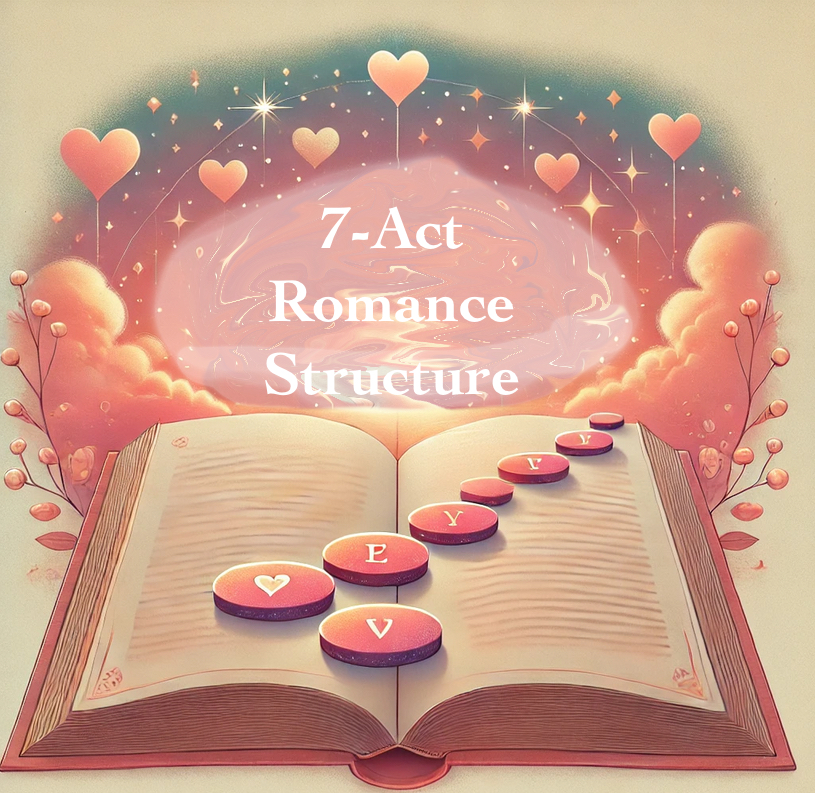
Mastering the 7-Act Romance Structure: A Blueprint for Unforgettable Love Stories
If you’re a romance writer, you know that crafting a compelling love story isn’t just about the meet-cute and the happily-ever-after. It’s about guiding readers through the emotional journey of your characters as they struggle, grow, and ultimately fall head over heels for each other. To do this effectively, many successful romance novels follow a 7-act structure—a framework designed to hit all the beats readers crave, from initial attraction to that heartwarming finale.
In this post, we’ll walk you through the basics of the 7-act romance structure, showing you how each act builds the romance while deepening character development. Whether you’re new to writing romance or just looking to sharpen your plotting skills, these seven acts will give your love story the foundation it needs to hook readers from beginning to end.
Act 1: The Meet Cute (or Re-Meet or Meet Ugly)
Every romance starts with a spark. The first act is where your hero and heroine meet for the first time—or in some cases, run into each other again after a long absence. The meet-cute is all about setting up that initial chemistry or tension, hinting at the deeper connection that’s yet to come.
Example: Think of the tension in Pride and Prejudice when Elizabeth Bennet first meets Mr. Darcy. There’s attraction, but also an initial clash that sets the tone for what’s to come.
Act 2: Building Interest and Attraction
Once your characters have met, it’s time to let that attraction simmer. This act is all about creating opportunities for them to interact, slowly building both romantic tension and genuine interest. Let them see sides of each other that spark curiosity, admiration, or even irritation—the emotions that make them start to feel something deeper.
Example: In The Hating Game by Sally Thorne, the forced proximity of Lucy and Joshua working in the same office builds tension and attraction as they begin to see beyond their initial impressions of each other.
Act 3: First Moment of Vulnerability
A well-placed moment of vulnerability lets characters drop their guard and show each other their more genuine, perhaps even flawed, selves. This act is key because it builds intimacy and trust—two elements essential to any compelling romance. At this stage, they may not yet recognize their feelings as love, but they’re drawn closer than they intended to be.
Example: In The Flatshare by Beth O’Leary, Tiffy and Leon start leaving each other notes as they share the same apartment at different times, and these notes become an outlet for their true thoughts and worries.
Act 4: Deepening the Connection
This is where things start to heat up! In Act 4, you’ll want to show the couple sharing deeper moments together, allowing their relationship to grow. Here, they may start acknowledging their feelings to themselves, if not to each other. This is where you really build the emotional stakes, letting readers become fully invested in the relationship.
Example: In It Happened One Summer by Tessa Bailey, Piper and Brendan open up about their insecurities and pasts, revealing the things that make them vulnerable, further deepening their connection.
Act 5: The Point of No Return
Every romance has a point where the characters realize they’re in too deep to walk away without getting hurt. In this act, there’s often a dramatic turning point or a small crisis that forces them to make a choice. They’ve developed real feelings, but something—whether it’s an external event or an internal realization—now challenges them to step up or pull away.
Example: In The Kiss Quotient by Helen Hoang, Stella and Michael realize that their initial agreement no longer fits their feelings, forcing them to face the real emotions that have grown between them.
Act 6: The Big Conflict
Every romance needs that moment where it all seems to fall apart, where the conflict (often seeded throughout the earlier acts) finally comes to a head. This is where insecurities flare, misunderstandings deepen, or life circumstances get in the way. In Act 6, your characters are forced to confront what’s holding them back—often needing to make sacrifices or come to terms with their deepest fears.
Example: In Beach Read by Emily Henry, January and Gus’s differing views on life and love come crashing down, leading to a confrontation that forces them to decide what they truly want.
Act 7: The Resolution and Commitment
The final act is where everything comes together. After overcoming their personal obstacles, the hero and heroine realize they’re ready to commit, expressing their love openly and fully. This act can end with a grand declaration, a quiet moment of understanding, or even a glimpse into their future together—whatever feels authentic to the characters and their journey.
Example: In People We Meet on Vacation by Emily Henry, Alex and Poppy finally confess their feelings, realizing that their connection is too strong to let slip away.
The Epilogue: A Hint of the Future
In romance, readers love to see how the relationship plays out after that final commitment, which is why many stories end with an epilogue. Whether it’s a brief scene showing the couple’s life months or years later, or a hint at the adventures they’ll face together, an epilogue can provide a sense of closure, making readers feel the relationship is as solid as the characters have hoped.
Example: In The Friend Zone by Abby Jimenez, the epilogue shows the couple’s future with children, giving readers a rewarding glimpse of their new life.
Ready to Take Your Romance Writing to the Next Level?
Understanding the 7-act romance structure can transform the way you approach writing love stories. By mapping out these key moments and building your characters’ arcs around them, you’ll have all the tools you need to write a romance that resonates and captivates.
If you’re excited to dive deeper, stay tuned for my upcoming book on the 7-act romance structure! This guide will give you in-depth insights, writing exercises, and character-building tips designed to help you bring unforgettable romances to life. Whether you’re a beginner or a seasoned writer, this book will be your go-to resource for creating love stories readers can’t put down.
 Complete Guide Available at Amazon: https://amzn.to/3Zp2zAQ
Complete Guide Available at Amazon: https://amzn.to/3Zp2zAQ
Happy Writing!
Patti Ann

